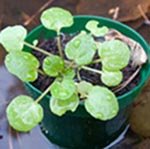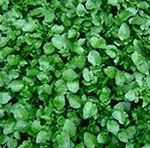Watercress Nutrition facts
Watercress is an aquatic perennial herb found in abundance alongside slow-running waterways and nearby natural springs. The pepper-flavored greens have been in cultivation since ancient times for their food and medicinal values in the South-East and Central Asia, Europe, and the Americas.
Botanically this fast-growing, leafy vegetable belongs to the Brassicaceae family, and closely related to mustard greens, garden cress, cabbage, salad rocket (arugula), etc.
Scientific name: Nasturtium officinale.
 |
 |
| Watercress plant. Note oval, green, succulent leaves. (Photo-by tonyaustin) | Nasturtium officinale-cress greens. |
Watercress is a free-floating hollow stemmed plant. It's small, oval, and dark green; succulent leaves carry high moisture content. The greens feature a sharp, peppery, and slightly tangy taste, somewhat like that of tender mustard greens and garden cress (Lepidium sativum).
Racemes of tiny white flowers appear in summer, which turns into small pods containing two rows of seeds. The mature cress seeds are also edible.
Health benefits of Watercress
Peppery and tangy flavored cress is a storehouse of many natural phytonutrients like isothiocyanates that have health promotional and disease prevention properties.
Cress is one of the very low-calorie green leafy vegetables (only 11 calories per 100 g raw leaves) and contains negligible amounts of fats. For the same reasons, these greens are often recommended in cholesterol-controlling and weight-reduction programs for their overall antioxidant, low-calorific and low-fat properties.
According to the study published in Centers for Disease Control and Prevention (CDC) journal, researchers at William Paterson University in New Jersey, watercress is labeled as the most nutrient-dense food, and for the same reason, it tops the list of "powerhouse fruits and vegetables."
Cress leaves and stem contain gluconasturtiin, a glucosinolate compound that gives the peppery flavor. Research studies suggest that the hydrolysis product of gluconasturtiin, 2-phenethyl isothiocyanate (PEITC), is believed to be cancer-preventing by inhibition of phase-I enzymes (mono-oxygenases and cytochrome P450s).
Fresh cress has a higher concentration of ascorbic acid (vitamin-C) than some of the fruits and vegetables. 100 g of leaves provide 47 mg or 72% of RDA of vitamin C. As an antioxidant, vitamin C helps trap free-oxygen radicals and reactive oxygen species (ROS) through its reduction potential properties.
Lab studies suggest that regular consumption of foods rich in vitamin C contributes to maintaining healthy connective tissue, prevents iron deficiency, and also helps the human body develop resistance against infectious agents by boosting immunity.
It is one of the excellent vegetable sources for vitamin-K; 100 g provides over 200% of the daily recommended intake. Vitamin K has a potential role in bone health by promoting osteoblastic (bone formation and strengthening) activity.
Also, sufficient vitamin-K levels in the diet help limit neuronal damage in the brain; thus, it has an established role in the treatment of patients who have Alzheimer's disease.
Cress is also an excellent source of vitamin-A, and flavonoids antioxidants like ß-carotene, lutein, and zea-xanthin.
It is also rich in the B-complex group of vitamins such as riboflavin, niacin, vitamin B-6 (pyridoxine), thiamin, and pantothenic acid that are essential for optimum cellular metabolic functions.
Further, it is also a rich source of minerals like copper, calcium, potassium, magnesium, manganese and phosphorus. Potassium is an important component of cells and body fluids that helps regulate heart rate and blood pressure by countering the effects of sodium. Manganese is used by the body as a co-factor for the antioxidant enzyme, superoxide dismutase. Calcium is required as bone/teeth mineral and in the regulation of heart and skeletal muscle activity.
Consumption of cress in the diet has been found to prevent osteoporosis, anemia, and vitamin-A deficiency and is believed to protect from cardiovascular diseases and colon and prostate cancers.
| Principle | Nutrient Value | Percent of RDA |
|---|---|---|
| Energy | 11 kcal | <1% |
| Carbohydrates | 1.29 g | 1% |
| Protein | 2.30 g | 4% |
| Total Fat | 0.10 g | 0.5% |
| Cholesterol | 0 mg | 0% |
| Dietary Fiber | 0.5 g | 1% |
| Vitamins | ||
| Folates | 9 µg | 2% |
| Niacin | 0.200 mg | 1% |
| Pantothenic acid | 0.310 mg | 6% |
| Pyridoxine | 0.129 mg | 10% |
| Riboflavin | 0.120 mg | 9% |
| Thiamin | 0.090 mg | 7.5% |
| Vitamin A | 3191 IU | 106% |
| Vitamin C | 43 mg | 72% |
| Vitamin E | 1.0 mg | 7% |
| Vitamin K | 250 µg | 208% |
| Electrolytes | ||
| Sodium | 41 mg | 3% |
| Potassium | 330 mg | 7% |
| Minerals | ||
| Calcium | 120 mg | 12% |
| Copper | 0.077 mg | 8.5% |
| Iron | 0.20 mg | 2.5% |
| Magnesium | 21 mg | 5% |
| Manganese | 0.244 mg | 11% |
| Phosphorus | 60 mg | 8% |
| Selenium | 0.9 µg | 1.5% |
| Zinc | 0.11 mg | 1% |
| Phyto-nutrients | ||
| Carotene-ß | 1914 µg | -- |
| Carotene-α | 0 µg | -- |
| Lutein-zeaxanthin | 5767 µg | -- |
Selection and storage
Watercress is available year-round. In the stores, purchase thick, broad, succulent, and deep green-colored fresh leaves. Fresh cress leaves should impart a tangy, peppery aroma when squeezed between thumb and index fingers.
In general, this green leafy herb best grows in aquatic environments; therefore, it should be washed in clean running water and then soaked in salt water for about half an hour in order to rid of parasite eggs and worms that thrive well under aquatic conditions.
Fresh greens may be submerged in water and stored in the refrigerator, where they keep well for up to 2-3 days.
Preparation and serving methods
Watercress gives a wonderful peppery flavor to the recipes. Soak in cold water for a few minutes to revive sunken leaves. Remove its roots from the stem and leaves. Then, rinse once again in clean water and pat dry before use in the cooking. Trim away thick fiber stems.
Here are some serving tips:
Fresh cress sprigs used in green salads.
The greens are used in many European cuisines in sandwiches and vegetable drinks.
They are also used in the preparation of soups.
Cress leaves can also be steamed and eaten as a vegetable.
Safety profile
Buy watercress from known cultivated farms that use clean running water. Cress from stagnant and polluted water may host some harmful parasites like flukes and larvae.
Watercress leaves carry 0.31 mg of oxalic acid per 100 g of leaves. Oxalic acid is a naturally occurring substance found in some vegetables, which may crystallize as oxalate stones in the urinary tract in some people. Therefore, individuals with known oxalate urinary tract stones are advised to avoid eating vegetables belonging to the Brassica family.
Being a Brassica family vegetable, cress may also contain goitrogens, which may interfere with thyroid hormone production and can cause thyroxin hormone deficiency in individuals with thyroid dysfunction. (Medical disclaimer).
≺≺ Back to Vegetables from Watercress. Visit here for an impressive list of vegetables with complete illustrations of their nutrition facts and health benefits.
≺≺ Back to Home page.
Further reading:
Stanford School of Medicine Cancer information Page-Nutrition to Reduce Cancer Risk.
Centers for disease control and prevention (CDC), Preventing chronic disease.